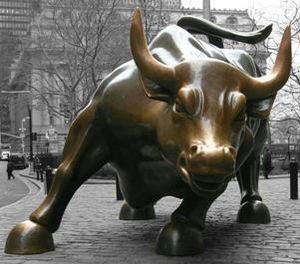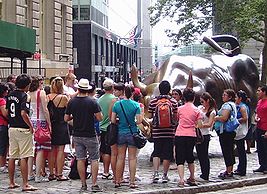- Charging Bull
-
Coordinates: 40°42′20″N 74°00′48″W / 40.705576°N 74.013421°W
Charging Bull, which is sometimes referred to as the Wall Street Bull or the Bowling Green Bull, is a 3,200-kilogram (7,100 lb) bronze sculpture by Arturo Di Modica that stands in Bowling Green Park near Wall Street in Manhattan, New York City. Standing 11 feet (3.4 m) tall[1] and measuring 16 feet (4.9 m) long,[2] the oversize sculpture depicts a bull, the symbol of aggressive financial optimism and prosperity, leaning back on its haunches and with its head lowered as if ready to charge. The sculpture is both a popular tourist destination which draws thousands of people a day, as well as "one of the most iconic images of New York"[3] and a "Wall Street icon"[4] symbolizing "Wall Street" and the Financial District.
In Outdoor Monuments of Manhattan: A Historical Guide, Dianne Durante describes the sculpture:
The Bull's head is lowered, its nostrils flare, and its wickedly long, sharp horns are ready to gore; it's an angry, dangerous beast. The muscular body twists to one side, and the tail is curved like a lash: the Bull is also energetic and in motion.[5]
The bronze color and hard, metallic texture of the sculpture's surface emphasises the brute force of the creature. The work was designed and placed so that viewers could walk around it, which also suggests the creature's own movement is unrestricted — a point reinforced by the twisting posture of the bull's body, according to Durante.
Charging Bull, then, shows an aggressive or even belligerent force on the move, but unpredictably. [...] [I]t's not far-fetched to say the theme is the energy, strength, and unpredictability of the stock market."[5]
"That bull is one of an edition of five", Di Modica told the New York Daily News in 1998. "I'm hoping the other four will be going to cities all over the world, whenever somebody buys them."[6] In 2010, a similar Charging Bull sculpted by Di Modica which looks "younger" and "stronger" was installed in Shanghai.
Contents
Construction and installation
Di Modica spent some US$ 360,000 to create, cast, and install the sculpture following the 1987 stock market crash as a symbol of the "strength and power of the American people."[2] The sculpture was the artist's idea, not the city's. In an act of "guerrilla art", he trucked it to Lower Manhattan and on December 15, 1989, installed it beneath a 60-foot Christmas tree in the middle of Broad Street in front of the New York Stock Exchange as a Christmas gift to the people of New York. That day, crowds came to look at the bull, with hundreds stopping to admire and analyze the gift as Di Modica handed out copies of a flier about his artwork.[2]
The police seized the sculpture and placed it into an impound lot. The ensuing public outcry led the New York City Department of Parks and Recreation to install it two blocks south of the Exchange in the plaza at Bowling Green. It faces up Broadway.[7]
Ownership
In 2004, Di Modica announced that the bull sculpture was for sale, on condition the buyer does not move it from its present location. Di Modica continues to own the copyright to the statue. In 2006, Di Modica sued Wal-Mart and other companies for illegally benefiting from his copyright, by selling replicas of the bull and using it in advertising campaigns.[8] In 2009, Di Modica sued Random House for using a photo of the bull on the cover of a book discussing the collapse of financial services firm Lehman Brothers.[9]
Since New York City does not own the sculpture, it has a technically temporary permit allowing it to stand on city property, but the temporary permission has lasted since 1989, when city officials said the new location would not be permanent.[10] Art on loan is usually limited to a year's display. Although the city does not buy art, it accepts donations.[11] A writer in the New York Daily News wrote in 1998 that the statue's placement was "beginning to look a mite permanent".[6] According to an article in Art Monthly, Di Modica, "the authorities, and New York public, view it as a permanent feature of Lower Manhattan."[12]
As a tourist attraction
As soon as the sculpture was set up at Bowling Green, it became "an instant hit".[11] One of the city's most photographed artworks, it has become a tourist destination in the Financial District. "[I]ts popularity is beyond doubt", a New York Times article said of the artwork. "Visitors constantly pose for pictures around it." Adrian Benepe, the New York City parks commissioner, said in 2004, "It's become one of the most visited, most photographed and perhaps most loved and recognized statues in the city of New York. I would say it's right up there with the Statue of Liberty."[1] In 1993, Arthur J. Piccolo, chairman of the Bowling Green Association, made the same point with the same comparison.[11] Henry J. Stern, the city parks commissioner when the statue first appeared in the Financial District, said in 1993: "People are crazy about the bull. It captured their imagination."[11]
The statue's popularity with tourists has a very international appeal. One 2007 newspaper report noted a "ceaseless stream" of visitors from India, the United Kingdom, South Africa, Venezuela and China, as well as the United States. Children enjoy climbing on the bull,[13] which sits "famously"[5] at street level on the cobblestones at the far northern tip of the small park. One popular tourist guidebook assumes that a visitor will want to get his or her picture taken with the statue ("after you pose with the bull [...]").[14] A popular Bollywood movie, Kal Ho Naa Ho features the bull in a musical number, increasing its familiarity with Indians. One visitor told a newspaper reporter it was a reason for his visit.[3]
In addition to having their pictures taken at the front end of the bull, many tourists pose at the back of the bull, near the large testicles "for snapshots under an unmistakable symbol of its virility."[15] According to a Washington Post article in 2002, "People on The Street say you've got to rub the nose, horns and testicles of the bull for good luck, tour guide Wayne McLeod would tell the group on the Baltimore bus, who would giddily oblige."[16] According to a 2004 New York Times article, "Passers-by have rubbed — to a bright gleam — its nose, horns and a part of its anatomy that, as Mr. Benepe put it gingerly, 'separates the bull from the steer.'"[1]
A 2007 newspaper account agreed that a "peculiar ritual" of handling the "shining orbs" of the statue's scrotum seems to have developed into a tradition. One visitor, from Mississippi, told the Tribeca Trib she did it "for good luck", and because "there’s a kind of primal response when you see something like that. You just have to engage it."[3] The enthusiastic reaction to the sculpture continues into the darker hours. "I’ve seen people do some crazy things to that bull," said a souvenir vendor, "At night sometimes, when people have been drinking, I’ve seen them do stuff to that bull that you couldn’t print in a newspaper."[3]
In popular culture
The sculpture is featured in the films For Richer or Poorer (1997), Hitch (2005), Inside Man (2006), The Other Guys (2010), The Sorcerer's Apprentice (2010), and Arthur (2011), as well as the TV series My Life as Liz. A dancer poses in arabesque atop the sculpture in the 2011 Adbusters appeal to "Occupy Wall Street".[17]
See also
- 26 Broadway, the building across the street from the statue, to the east
- Bund Bull
- Cows on Parade
- Golden calf
- Market sentiment
- Sports Museum of America at 26 Broadway, across the street
References
- Notes
- ^ a b c Dunlap, David W. "The Bronze Bull Is for Sale, but There Are a Few Conditions", article, The New York Times, December 21, 2004, retrieved June 13, 2009
- ^ a b c D. McFadden, Robert (1989-12-16). "SoHo Gift to Wall St.: A 3½-Ton Bronze Bull". New York Times. http://query.nytimes.com/gst/fullpage.html?res=950DE6DF103AF935A25751C1A96F948260. Retrieved 2007-10-01.
- ^ a b c d Pinto Nick, "Bull!", article, September 1, 2007, The Tribeca Trib, retrieved June 13, 2009
- ^ Greenfield, Beth and Robert Reid, Ginger Adams Otis, New York City, p 120, publisher: Lonely Planet, 2006, ISBN 1740597982, ISBN 9781740597982 retrieved via Google Books on June 13, 2009
- ^ a b c Durante, Dianne L., Outdoor monuments of Manhattan: a historical guide, NYU Press, 2007, ISBN 0814719872, 9780814719879, retrieved via Google Books on June 13, 2009
- ^ a b Singleton, Don, "Rock Solid", article, May 3, 1998, New York Daily News, retrieved June 13, 2009
- ^ "Wall St.'s Bronze Bull Moves 2 Blocks South". New York Times. 1989-12-20. http://query.nytimes.com/gst/fullpage.html?res=950DE3D9103AF933A15751C1A96F948260. Retrieved 2007-10-01.
- ^ "Sculptor of Manhattan 'Charging Bull' statue sues Wal-Mart, others to protect its image". Associated Press. 2006-09-21. http://www.signonsandiego.com/news/nation/20060921-1411-chargingbulllawsuit.html. Retrieved 2007-07-20.
- ^ Bray, Chad (2009-07-29). "Artist Sues Random House Over Use Of Wall St Bull Image". Dow Jones Newswires. http://online.wsj.com/article/BT-CO-20090729-722387.html. Retrieved 2009-07-29.
- ^ "Wall St.'s Bronze Bull Moves 2 Blocks South", Associated Press article, as printed in The New York Times, December 20, 2009, retrieved June 13, 2009
- ^ a b c d Lambert, Bruce, "Neighborhood Report: Lower Manhattan; A Campaign To Save a Bull", article, The New York Times, October 3, 1993, retrieved June 13, 2009
- ^ Lydiate, Henry, "Public sculpture.(COPYRIGHT)", article, November 1, 2006, Art Monthly, retrieved via the "Access My Library" website, June 13, 2009
- ^ Sommers, Carl, "Q and A", May 26, 1991, The New York Times, October 3, 1993, retrieved June 13, 2009
- ^ Eisenberg, Paul, and Erica Duecy, Jennifer Paull Fodor's New York City 2008, Random House, Inc., 2007, ISBN 1400017939, 9781400017935, retrieved June 13, 2009
- ^ Dunlap, David W., Downtown’s Bull, No Longer Emblematic, Remains Popular, September 16, 2008, The New York Times, retrieved June 13, 2009
- ^ Duke, Lynn, "The Pilgrimage To Ground Zero — Officials and Tourists Walk A Fine Line on Solemn Ground", Washington Post, February 27, 2002, Edition F, page C1, accessed via newsbank.com subscription archive website (also on High Beam Research subscription archive website) on May 4, 2008
- ^ Beeston, Laura (October 11, 2011). "The Ballerina and the Bull: Adbusters’ Micah White on ‘The Last Great Social Movement’". The Link. http://thelinknewspaper.ca/article/1951. Retrieved 2011-10-12.
- Further reading
- Durante, Dianne, Outdoor Monuments of Manhattan: A Historical Guide (New York University Press, 2007): on the Bull's creation and current legal status.
External links
- RoadsideAmerica.com article citing many examples of statues that visitors rub
- " A New York Story: How the Charging Bull Chose Wall Street" By Tiziano Thomas Dossena, Bridge Puglia USA, June 2011
Categories:- Fictional cattle
- Outdoor sculptures in New York City
- 1989 works
- 20th-century sculptures
- Animals in art
Wikimedia Foundation. 2010.



